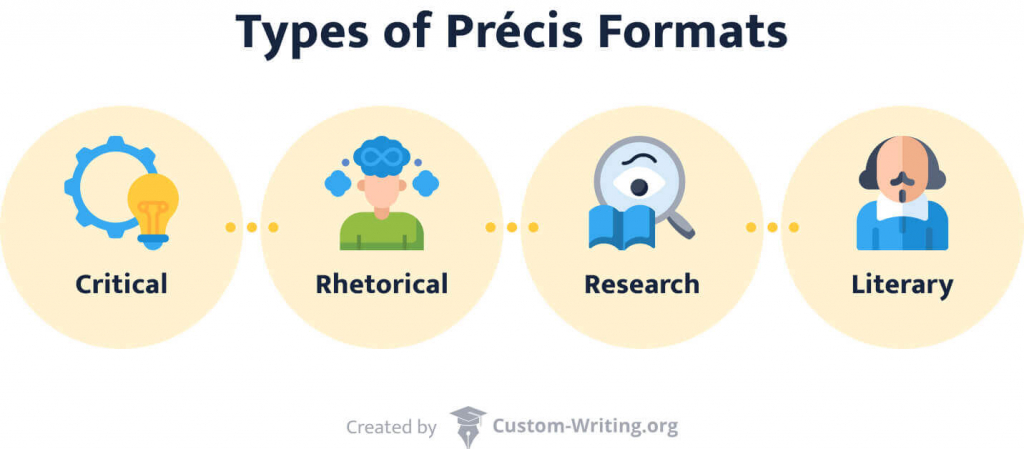A précis is a very brief synopsis of a written piece. In a good précis example, you will find a thorough summary and analysis of a text’s main points. However, it’s important that a précis condenses the arguments, not the entire paper, and the shorter, the better. It also doesn’t have to follow the structure of the source point-by-point – instead, the précis format usually presents an argumentative structure of the piece.
If you need to write a rhetorical précis for a research paper or the AP Lang exam, you’ve come to the right place. In this comprehensive guide by Custom-Writing.org, you’ll find:
- Precis definition
- Explanations of different précis formats
- A step-by-step writing guide
- 4 précis examples
- Answers to frequent questions, including “What is a precis?”
📚 What Is a Precis?
Précis is a type of writing that represents a text’s crucial ideas and has a fixed structure. It’s a common form of summarization in academic and non-academic literature. Academic articles use précis to relay complex ideas in a concise, easily digestible format, while non-academic publications may use this type of summary to aid readers’ understanding without the need to study full texts.
Writing a précis can be helpful in numerous cases, such as:
- preparation for complex text analysis,
- creation of an annotated bibliography,
- summarizing a lengthy research paper,
- improvement of critical thinking and analytical skills.
How Long Should a Precis Be?
The length of a précis can vary depending on the format and original text. According to précis writing rules, the rhetorical format should consist of 4 sentences, each being a separate paragraph. A précis is supposed to be about 100-200 words long. Sometimes, it can be 1/5 of the original text’s length.
Précis vs. Summary
Even though “summary” is a synonym of “précis,” there are several essential differences between these two notions. The main distinction lies in structure: a précis always consists of 4 sentences, while a summary’s format can vary.
Have a look at the comparison below:
📌 Précis
- Comprises exactly 4 laconic sentences.
- Covers only the essential ideas.
- Emulates the original text’s writing tone and style.
📌 Summary
- Varies in structure and usually follows the analyzed work.
- Incorporates all of the text’s aspects.
- Can be written in any style and doesn’t have to follow the text’s original tone.
Précis vs. Paraphrasing
Précis writing differs drastically from paraphrasing in terms of purpose and scope:
- Précis is meant to present a shortened version of the content’s key idea. It is intended to retain the meaning of the entire text in a condensed, significantly shortened form.
- Paraphrasing restates information from the source using one’s own words and interpretation without condensing the overall content. It’s typically done with separate passages rather than full texts.
Overall:
A précis is a brief representation of the entire reading piece, while a paraphrase is a reworded fragment of that material.
Précis vs. Critical Analysis
A précis is fundamentally different from a critical analysis. Here are the main distinctions to keep in mind:
- Degree of objectivity. A précis is a non-evaluative, objective summary of the assigned material, while a critical analysis is the author’s subjective interpretation of the assigned reading.
- Content evaluation. When writing a précis, you don’t engage in content evaluation. On the other hand, critical analysis requires the writer to assess the content’s structure, main idea, arguments’ strength, the methodology’s correctness, etc.
- The tone of writing. A précis is composed in a neutral tone without the author’s subjective reasoning. In contrast, a critical analysis piece should be written in an argumentative style to convince the readers of the plausibility and correctness of the author’s assessment.
To sum up:
A précis is about condensing and clarifying the main points, while critical analysis is centered on an evaluative exploration of the reading’s quality.
💡 Précis Format: 4 Sentences Explained
Précis is close to an essay in format, but it consists of only 4 sentences with specific content:
- Author’s name, genre, and title of work. It also contains the thesis statement (what the author claims or suggests.)
- Close examination of the thesis and its revelation, usually in the same order as in the original text.
- Explanation of the work’s purpose. This part answers the questions “why?” and “what for?”
- Description of the tone and the audience. This sentence discusses who the author appeals to.
📝 Main Précis Types
Now, you know what a précis is, but that’s not all of it. There are also different formats of précis writing: critical, rhetorical, research, and literary. In this section, we will examine their components and structure.

Critical Precis Definition & Structure
A critical précis focuses on an argument and reveals the text’s reasoning. It’s also the most frequent of all formats. While working on such a précis, follow these writing rules for each segment:
- Formulate an argument expressed in the original piece.
- Indicate the author’s reasoning and its essential components.
- Analyze the evidence the author uses to corroborate their argumentation.
- Discuss what kind of audience the work appeals to.
Rhetorical Precis Definition & Structure
A rhetorical précis is an analytical review of the original text’s subject matter and persuasive techniques. It reveals the fundamental ideas of the paper and shows how it works rhetorically. This format is one of the AP Lang assignments.
Each of the 4 elements of a rhetorical précis structure expresses particular information:
- Background and thesis statement.
- The argument used to support the core point.
- Explanation of the text’s purpose.
- Analysis of the rhetorical devices the author utilizes to convince the readers.
Research Precis Definition & Structure
Research précis is similar to the critical one, except it’s meant to present a concise, structured synopsis of a scholarly paper.
The 4 elements of this précis type are as follows:
- Description of the work’s purpose and issues raised in it.
- Overview of all the methods utilized by the researcher.
- Summary of the practical results and findings.
- Reasoning of the study’s significance.
Literary Precis Definition & Structure
Literary précis is an argumentative overview of a text with special attention to its literary devices. The purpose and contents of this type significantly differ from others.
Have a look at this format’s structure:
- The work’s title, genre, and central theme.
- Plot summary: the principal characters, place and time of the narration, and the primary conflict.
- The text’s overall purpose: what thoughts it intends to evoke in the minds of the audience.
- The exploration of literary devices that help to accomplish the desired result.
✅ How to Write a Precis Step by Step
To compose a well-structured précis, you will need to summarize the text’s essence concisely and effectively. Here are the steps you should follow to receive the required result and not just a simple summary:
- Choose the text. The first stage is selecting the text you will condense. It can either be assigned by your professor or chosen by you; just make sure it has a clear structure and comprehensible content.
- Read it closely. The next phase is close reading, with the aim of understanding the text’s content, main arguments, structure, and central idea. It’s best to read it attentively and slowly to capture all the nuances of meaning.
- Take notes. Reread the text once again with a focus on the minor details of the content. As you read, note the main points you need to cover in the précis.
- Outline the précis. Create a detailed plan based on your notes. Jot down the main arguments and dedicate a separate paragraph to each of them in the précis.
- Write the draft. Now, you can start working on the précis itself. Connect all ideas with relevant transitions to make the text cohesive and ensure it flows well. Use clear language and syntax to create a tight, informative précis.
- Polish the text. Finally, it’s time to review the resulting text and correct all possible errors and imperfections. Polish the final draft so that it fetches you a high grade.
By following this algorithm, you’re sure to produce an effective précis that condenses the original material in a clear, readable format.
Précis Writing Checklist
To ensure your précis’ quality, double-check whether it is:
- Clear and precise. A good précis should distill the gist of the assigned reading without losing vital data and going into too much.
- Unique. Make sure you convey the content in your own words instead of copying parts of the original.
- Only the gist. You should capture the original’s core message and main details without summarizing it in a traditional sense.
- Objective and logical. The précis should be coherent, logical, and readable, helping the reader grasp the main idea of the original.
🎓 Précis Template with Examples
Below you’ll find a detailed outline for each of the 4 précis parts. Use it to make your writing process effortless:
Sentence #1. Give some general information about the text.
- State the work’s title and the author’s name. You can also add some publishing information, such as the number of the edition.
- Mention the text’s fundamental idea or message using verbs such as “state,” “suggest,”, or “argue.”
Example:
In his article “Diglossia” (1958), Jarls Ferguson suggests the term diglossia describes the situation of unbalanced bilingualism with different functional areas of language circulation for local spoken variants.
Sentence #2. Show how the author develops their arguments and supports the thesis.
- Focus on the evidence they employ rather than on individual details of their reasoning. Use verbs like “compare,” “explain,” “define,” and “describe.”
- When writing a literary précis, concentrate on the devices that help unravel the central theme.
Example:
The author supports her assertion by showing her personal experience and struggle against Taliban supporters who shot her for her willingness to study at school.
Sentence #3. Clarify the purpose of the piece.
- If you’re writing a rhetorical or critical précis, build your sentences using the phrase “in order to.”
- Avoid reiterating the thesis. Instead, elaborate on the author’s motives and goals using verbs like “show,” “point out,” “persuade,” and others.
Example:
Bradbury’s overall purpose is to show the problem of censorship in the era of high technology to convince people that literature and culture are crucial for humanity.
Sentence #4. Demonstrate what type of audience the author appeals to.
- To detect the intended audience, analyze the text’s theme, thesis, and tone. The latter can be formal, sarcastic, informal, or humorous, among others.
- The type of audience usually depends on the author. For example, scholars typically appeal to their colleagues interested in the topic. Writers of fiction can appeal to any social group or society as a whole.
Example:
The author establishes a formal and analytical tone with his audience of scholars interested in linguistics and philology.
Rhetorical Precis Template
To help you structure your précis, we’ve created a sample template that you can download in PDF format below. All you need to do is to print it out and fill in the blanks.
Example:
- [Name of the author] in his/her [type of the text] titled [the text’s title] argues that [the text’s main argument].
- The author supports his/her arguments by [evidence presented by the author].
- The author’s purpose is to [what the author wants to achieve] in order to [the text’s intended effect on readers].
- The author writes in a [description of the text’s tone] tone for [the type of audience].
📋 Precis Examples: Different Types
We’ve prepared for your high school and college examples of different précis to help you write one of your own. Feel free to use them as inspiration.
Critical Precis Example
1st sentence
In his speech I Have a Dream (1963), American civil rights activist and minister Martin Luther King asserts that all people in the United States should enjoy equal rights regardless of their skin color or ethnicity.
2nd sentence
King supports his assertion by using powerful metaphors to show the racial inequality in the USA and by repeating the phrase “I have a dream” to establish the goals the society needs to achieve for developing civil rights.
3rd sentence
The speaker aims to convince people that segregation policy and racism are harmful to society and lead to inequality and social conflicts.
4th sentence
King addresses his speech to the government and Americans and uses a serious but inspiring tone.
Rhetorical Precis Example
1st sentence
Young Pakistani female activist and Nobel Peace Prize laureate Malala Yousafzai, in her speech at the Youth Takeover of the United Nations (2013), asserts that equal education for both men and women is the key to the brightest future of humanity.
2nd sentence
She supports her assertion by showing her personal experience and struggle against Taliban supporters who shot her for her willingness to learn in school.
3rd sentence
Her purpose is to make the UN nations representatives and society bring their attention to the equality problems that millions of people face every day in developing countries.
4th sentence
Malala Yousafzai establishes a respectful but emotional tone to appeal to the broad audience in the United Nations and the whole world.
Research Precis Example
1st sentence
In their article “Why Molière Most Likely Did Write His Plays” (2019), published in Science Journal, Florian Cafiero and Jean-Baptiste Camps try to clear up uncertainties regarding the authorship of Molière’s works that were questioned by the public and scholars in the 20th century.
2nd sentence
Cafiero and Camps decided to determine the authorship of Moliere’s writing using a statistical analysis of the text and hierarchical clustering, which allows dividing objects into separate groups according to their proximity to each other.
3rd sentence
Researchers analyzed all similarities in texts and concluded that Moliere invented the plots for his plays and wrote them independently.
4th sentence
The study helped determine the authorship of Moliere’s plays and showed the effectiveness of using a hierarchical clustering method in such cases.
Literary Precis Example
1st sentence
In his famous novel Fahrenheit 451, published in 1953 by Ballantine Books, Ray Bradbury addresses the downsides of mass media and technological development.
2nd sentence
The novel takes place in an unnamed American city in the distant future and follows the story of Guy Montag, an intelligent and empathetic fireman responsible for burning outlawed books who realizes how awful reality is and begins protesting against the system of suppressing free thinking.
3rd sentence
The author aims to show the adverse influence of technology and suppression on literature, culture, and society.
4th sentence
Bradbury develops his theme through a dystopian narrative to present the undesirable future, animal imagery to contrast nature and technologies, and repetitive patterns to underline his essential thoughts.
Precis Essay Topics
- Précis of Everyday Use by Alice Walker
- Write a summary of COVID-19 related articles
- Synopsis of On the American Working Class
- Create a précis of Wearables by Linnie Greene
- Present a brief summary of Overview of the Immune Response
- Write a synopsis of 3 lung cancer articles
- Précis of an article by Douglas C. Engelbart
- Write a concise synopsis of Consider the Lobster
- Present a précis of a journal article
- Summary of the article Coming to the Aid of Women in U.S. Prison by D.S. McClellan
- Come up with a synopsis of an article in Journal of Nutritional Biochemistry
- Summary of the article The HR Challenges Shaping the Healthcare Industry
- Write a synopsis of a research paper on evidence-based interventions for anxiety
- Make a précis of the study Practice Nurse Use of Evidence in Clinical Practice
- Present a short summary of the article Robotic Kidney Transplantation: One Year After the Beginning
- Create a synopsis of an article critique
- Short summary of the film The Great Debaters
- Summary of the article Breast Cancer and Exercise
- Write a synopsis of the article Assessment and Management of Sexual Dysfunction in the Context of Depression
- Précis of the article Maternal Stress and Sensitivity: Moderating Effect of Positive Affect
- Make a reading summary of two social articles
- Summary of Examining Evidence-Based Interventions to Prevent Inpatient Falls
- Short synopsis of the article You Know Nothing, John Doe!
- Précis and analysis of the article My Turn: $15 an Hour Minimum Wage Would Slow Economy
- Summary of McCallum’s Followership
- Present a comparative synopsis of Woolf’s and Brady’s feminist articles
- Précis of Business Careers with High Pay
- Summary of Women Should Have to Register for the Draft
- Write a synopsis of The Spirit in Creation by D. Williams
- Précis of sports and organizational conflict articles
- Write a summary and analysis of the article New Bases of Competitive Advantage
- Synopsis of Asleep on the Job
- Précis of Sleep, Health, and Wellness at Work
- Summary of Leadership Characteristics and Digital TransFormation
- Present a synopsis of Tweeting Social Change by Guo & Saxton
- Précis of the article The Nature of Things: Biomimicry
- Summary of How to Develop a Strategic Mindset
- Synopsis of Coalition Brings Pressure to End Forced Uighur Labor
- Write a précis of 2 gender inequality articles
- Present a summary of Chopin’s The Story of an Hour
- Synopsis of The Necklace
- Make a précis of The Garden Party by Catherine Mansfield
- Summary of Zika Virus Disease: A Public Health Emergency of International Concern
- Write a synopsis of Ibsen’s A Doll’s House
- Create a short précis of Letter from Birmingham Jail
- Make a summary of Seven Jewish Children by Caryl Churchill
- Synopsis of A Rose For Emily by Faulkner
- Present a précis of Googling Your Date by Martha Irvine
- Write a summary of Get Your Bonds Ready for a Fed Rate Boost
Now you’re ready to write your précis! Use this guide every time you need to write a task for college or if you need to prepare for AP Lang exams. We wish you best of luck with your writing assignments!
Further reading:
- How to Write an Abstract Step-by-Step: a Guide + Examples
- How to Write a Reflection Paper: Example & Tips
- How to Write a Critical Thinking Essay: Examples & Outline
- How to Write a Personal Essay: Topics, Structure, & Examples
🔍 References
- A Review of Critical Reading Skills: Palomar College
- Writing a Summary or Rhetorical Précis to Analyze Nonfiction Texts: University of Wisconsin-Madison
- Rhetorical Précis: Lumen Learning
- Writing a Useful Précis for a Research Article: University of Washington
- Précis: Texas A&M University
- How to Write a Précis: Monmouth University
- Writing a Précis: Wilfried Laurier University
- Mapping: Gallaudet University
- The Rhetorical Précis: Folsom Cordova Unified School District
- All about Précis Writing: Purdue University


![Critical Analysis Essay Example & Writing Guide [2025]](https://custom-writing.org/blog/wp-content/uploads/2021/10/business-men-sitting-lawyers-s-desk-people-signing-important-documents-284x153.jpg)





![How to Write an Argumentative Essay: 101 Guide [+ Examples]](https://custom-writing.org/blog/wp-content/uploads/2021/01/young-writer-taking-notes-284x153.jpg)

![How to Write about a Topic You Lack Interest in [2025]](https://custom-writing.org/blog/wp-content/uploads/2021/01/Frustrated-exhausted-young-woman-blogger-284x153.jpg)
